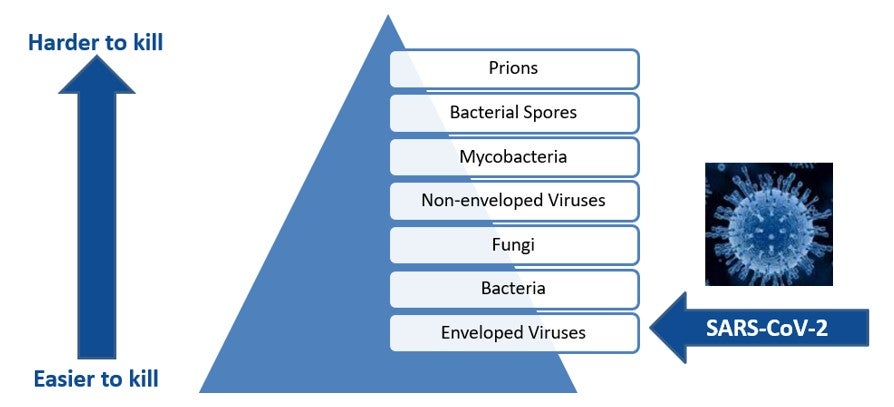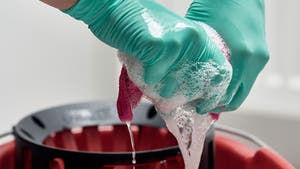This is the second post of a three-part blog series, COVID-19: Transition from Hospital to Home, by Doe Kley. Read part one and part three.
In part one of this blog series, we described COVID-19 disease and used the chain of infection to demonstrate how this and other infections occur. In part two of this series, we will address how the spread of COVID-19 can be prevented within the hospital, as well as how to prevent its spread to loved ones within the home.
Preventing Transmission in the Hospital
Measures the healthcare team is taking to prevent transmission of COVID-19 to patients and others within the hospital walls include:
- Screening everyone who enters the building for signs and symptoms consistent with COVID-19, including temperature checks or exposure to persons infected with SARS-CoV-2
- Having separate areas for evaluating patients suspected of having COVID-19 infection
- Restricting visitors
- Implementing isolation precautions as indicated
- Use of personal protective equipment such as masks or respirators, face shields, gloves, and gowns
- Performing frequent hand hygiene
- Ensuring spatial separation of at least six feet including in nurses stations and waiting rooms
- Use of barriers such as plexiglass to eliminate exposures
- Postponing elective surgeries and procedures
For additional recommendations, see CDC’s Interim Infection Prevention and Control Recommendations for Healthcare Personnel During the Coronavirus Disease 2019 (COVID-19) Pandemic.
For disinfectants effective against the SARS-CoV-2 virus, see the Environmental Protection Agency’s (EPA) List N. This list includes disinfectants used in healthcare settings as well as disinfectants used at home. It’s important to note that while SARS-CoV-2 can cause severe illness in some, the virus is very easy to kill on surfaces with appropriate disinfection.
Hierarchy of Pathogen Kill

For patients admitted for a health issue other than COVID-19, there are things that they can do to protect themselves from getting COVID-19 while in the hospital. First and foremost, patients must be their own advocate. This means speaking up when something doesn’t look or seem quite right. This includes reminding healthcare workers and visitors to perform hand hygiene before touching you. Along these same lines, patients should be sure to perform hand hygiene before they eat or before taking oral medications, after they use the restroom, and upon returning to their room from a test or procedure or even a walk in the halls. It’s also important to ensure your room and bathroom are cleaned every day you are in the hospital. Focal points for cleaning should include surfaces that are frequently touched such as the over-bed table, bed rails, call light, and tv remote to name a few. Additionally, patients should ensure that the healthcare team has disinfected any medical equipment that will come into contact with them. Lastly, during the pandemic, patients should wear a mask as tolerated while in the hospital to help prevent inadvertent exposure to COVID-19.
Similarly, there are things that essential workers can do to prevent bringing COVID-19 home from work with them and infecting their family members. The COVID-19 pandemic has certainly made us take a closer look at how we can safely transition from work to home each day to protect not only ourselves but our loved ones. Please see my blog post from March 2020 titled “From Outside In: 6 Tips for Minimizing the Risk of Bringing COVID-19 Home After Your Shift”.
Preventing Transmission in the Home
There are measures that patients infected with COVID-19 can do to prevent infecting their loved ones when it’s time to be discharged from the hospital. Adherence to the 6 basic measures that we all should be doing will go a long way in preventing the spread of COVID-19:
- Stay home if feeling unwell
- Practice social distancing
- Wear a mask and cover coughs/sneezes
- Avoid touching the face
- Perform frequent hand hygiene
- Perform frequent cleaning and disinfection of environmental surfaces
To clean surfaces in the home that may be contaminated with the SARS-CoV-2 virus be sure to use an EPA-registered household disinfectant. Most of these will be effective as this is not a difficult virus to kill (see Hierarchy of Kill image above). For a complete list of appropriate household disinfectants for COVID-19, visit the Clorox Coronavirus Resource page to view a list of approved products and tips on how to safely and effectively disinfect surfaces in the home. Additionally, diluted jug bleach can be used to disinfect surfaces.
1:10 Jug Bleach Dilution

In addition to frequent cleaning and disinfection of frequently touched surfaces in the home, only one person in the household should take care of the person who is ill. And this person should not be someone in the high-risk group for COVID-related complications. In addition to the 6 basic measures mentioned earlier, the ill person should:
- Stay home and stay away from other people,
- Follow the care instructions from their healthcare provider and be sure to get plenty of rest and stay hydrated, and most importantly,
- Monitor their symptoms and seek immediate medical attention by calling 911 in the event of difficulty breathing or you otherwise think it’s an emergency.
Everyone in the household, especially the ill person, should practice respiratory etiquette which includes covering coughs and sneezes, properly discarding used tissues, and performing frequent hand hygiene. Also, avoid sharing personal items with others in the home including dishes, towels, and bedding.
The COVID-19 infected person should remain separated from others in the household, including pets, by staying in a designated room. This person should also have a separate bathroom, if possible. If the bathroom must be shared, then after each use, the frequently touched surfaces should be cleaned and disinfected.
The bathroom and the “sick room” are not the only rooms in the house that should be cleaned frequently. All frequently-touched surfaces in the home should be cleaned and disinfected daily at a minimum according to the Centers for Diseases Control & Prevention (CDC), but it certainly doesn’t hurt to disinfect more frequently.
If sleeping in the same room is necessary, put a curtain up to act as a divider. And if you must share a bed, sleep head-to-toe. Weather permitting, open doors and windows and use fans to help circulate fresh air. The ill person should not prepare food and should eat separately from the rest of the family.
Read part 3 of the blog series as we end with the safe and proper use of disinfectants.
For the latest information on COVID-19 and variants, visit our CloroxPro COVID-19 Hub.


